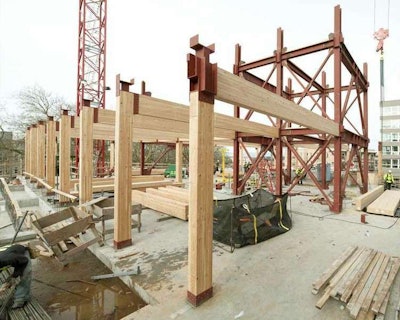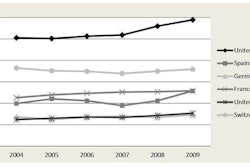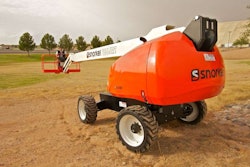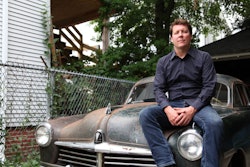 Construction of Seattle’s six-story wood-framed Bullitt Center. Credit: John Stamets/Bullitt Center
Construction of Seattle’s six-story wood-framed Bullitt Center. Credit: John Stamets/Bullitt Center“Green building” and the aim to reduce carbon emissions in the construction of a building are fine goals. But is this growing movement among architects and designers really enough to bring back the use of heavy timber for framing taller buildings?
After all, timber hasn’t been used consistently for framing since concrete and steel rose to favor after World War I. But on top of timber’s carbon-reducing benefits, proponents say it’s also simply better looking.
Brian Court of Seattle’s Miller Hull Partnership (recently named the city’s Young Architect of the Year) seems to think so. In an interview with the Minneapolis Star Tribune, the architect said there is currently “a huge movement right now” and a “kind of awakening, sort of the rebirth of timber.”
“If you consider the forest, when you’re growing the trees, carbon is sequestered in the wood. Even after you mill it, deliver it to the site and install it, all the energy it took to create that material is virtually offset by the sequestered carbon inside it, whereas concrete and steel require massive amounts of energy to generate the final structural product—tenfold, if not more,” Court said.
Back in June we told you about a 34-story wood framed skyscraper up for consideration in Stockholm, Sweden. Right now, Court isn’t expecting about a bunch of these types of wooden skyscrapers to pop up. But he does expect more and more buildings like the Bullitt Center, a six-story office building in Seattle that was recently completed.
Court desinged the wood-framed office building, composed of four floors of Douglas fir beams and columns atop two-stories of reinforced concrete base. The building also contains a steel beam core for reinforcement. The Bullitt Center has been been called “The Greenest Commercial Building in the World” and is built to last 250 years.
Court also addressed the main weakness of timber: fire. “But we can deal with that now. There were no sprinkler systems then,” he said, regarding the Great Chicago Fire of 1871. “Heavy timber, by virtue of its size, actually will burn for an hour or two before it loses its structural capacity.”









